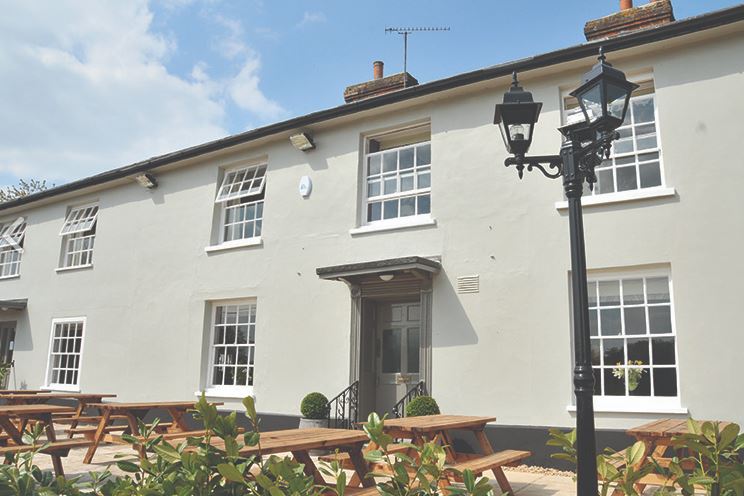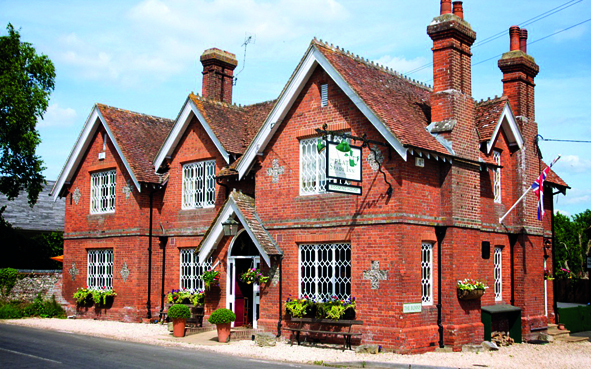The Hawk Inn sits in the lovely village of Amport in the Test Valley. Inside, exposed brick…
Around the Chutes

8 miles (12.9kms)
About the walk
This walk explores the hilly and relatively deserted border country between Wiltshire and Hampshire, in what remains of Chute Forest. In medieval times vast tracts of woodland canopied an area stretching from Savernake Forest in the north to Salisbury in the south, before swelling out again into the New Forest, providing a prime hunting ground.
The Chutes
The parishes of Chute and Chute Forest can be traced back to Norman times. It is believed that the ancient meaning of Chute is wood or forest. Habitation within the parishes at that time was probably no more than a few cottages in a large clearing occupied by charcoal burners or peasants. Deforestation began in 1632 under Charles I (1600–49), who divided the area up among his favoured nobles. The result of this is still evident today in the form of five small hamlets – Upper and Lower Chute, Chute Standen, Chute Forest and Chute Cadley – which developed around what were once farms or country houses, such as Standen House and Chute Lodge.
The landscape is still well wooded with a mixture of copse, plantations, windbreaks or 'rows' and roadside plantings of beech linked by a sprinkling of hedgerow trees. The paths and byways on this walk explore in depth this quite remote area of Wiltshire, which rises to over 800ft (244m), giving splendid views south across Hampshire to the Isle of Wight. The highest point of the walk is on the impressive Chute Causeway, originally part of the Roman highway from Winchester in Hampshire to Mildenhall, near Marlborough. It forms a great arc around some of the most attractive scenery in Wiltshire, for just north of the now-paved road are deep combes (such as Hippenscombe Bottom) and steep hills (such as Knolls Down). Even the Roman road, which usually ignores natural obstacles, swerves to avoid them. At the eastern end of the Causeway is Conholt House, a large, early 19th-century grey-brick building. It was here during excavations in 1898, that a small terrace set with 12–16 inches (30–41cm) of flint was uncovered. Part of this terrace appears to have been burned, which offers an explanation as to how the Romans built such straight roads – by lighting fires at both ends of the semicircular section of the Causeway they could line up the columns of smoke to align their road.
Walk directions
Turn left out of the car park and then right at the T-junction. Fork left at the war memorial, then turn left again by the 'Chute Cadley' village sign. Keep left and take the bridle path, a track, through the edge of woodland. Continue between hedgerows and descend into Chute Standen.
Turn right at the T-junction, then, where the lane swings left to Standen House, keep straight on up a grassy track of Breach Lane. At the T-junction, turn right and then left along the edge of woodland. Continue for 0.5 miles (800m) to Chute Causeway.
Cross straight over the causeway and later steeply descend the track to a metalled lane in Hippenscombe Bottom. Turn left, then right and swing right, then left between farm buildings. Fork right along a grassy track (passing to the right of a long, breeze-block barn), which soon swings left, and steadily ascend to a crossing of ways.
Turn sharp right along the gravel track. At Fosbury Farm, bear right and walk beside woodland. Follow the track into the woods and, as you leave the woods, cross a stile by a gate and briefly leave the marked route to pass through the ancient earthworks into Fosbury Ring on top of Knolls Down.
Fork left on a grassy track never far from the woodland. Pass to the right of a tiny screened pond, then swing left on a track, exit the ring and walk down the left-hand field-edge. Cross the stile in the corner and go around the left edge of a large field. Descend to a cottage in the corner. Turn right along the lane and go through the kissing gate almost immediately on your left. Keep to the right-hand field-edge to a kissing gate and road and turn right into Vernham Dean.
Take the waymarked fenced track beside a house called Underwood. The fencing on the right ends just before a gap; here turn right along a hedged track. Follow the track just within woodland, then follow the waymarkers carefully, steeply uphill across a field and through a small plantation to a gap. Turn left along the top of the escarpment to a gate in the corner on to the road.
Turn right, then, where the road swings sharp left by a junction, keep straight on through a gate. Initially head towards an open-sided barn, but then bear left across a depression and continue to another stile. Cross the next field to a stile and walk down a track between fields. Bear slightly left, then walk along the right-hand field-edge to enter a long, narrow field, bounded by woodland.
Keep to the right-hand edge and go by a redundant stile on the right just before the corner. Continue beside woodland, soon joining a drive which becomes a metalled lane. Turn right at the T-junction and go forward (not forking right) to retrace your steps back to the car park.
Additional information
Bridle paths, downland tracks, field paths, roads, several stiles
Farmland, woodland, downland pasture, village streets
Lead required around farmland and on road
OS Explorer 131 Romsey, Andover & Test Valley
Lower Chute Club
None on route
WALKING IN SAFETY
Read our tips to look after yourself and the environment when following this walk.
Find out more
Also in the area
About the area
Discover Wiltshire
A land shrouded in mystery, myth and legend, Wiltshire evokes images of ancient stone circles, white chalk horses carved into hillsides, crop circles and the forbidden, empty landscape of Salisbury Plain. To many M4 and A303 drivers heading out of London through the clutter of the Thames Valley, Wiltshire is where the landscape opens out and rural England begins.
Wiltshire’s charm lies in the beauty of its countryside. The expansive chalk landscapes of the Marlborough and Pewsey downs and Cranborne Chase inspire a sense of space and freedom, offering miles of uninterrupted views deep into Dorset, Somerset and the Cotswolds. Wiltshire’s thriving market towns and picturesque villages provide worthwhile visits and welcome diversions. Stroll through quaint timbered and thatched villages in the southern Woodford and Avon valleys and explore the historic streets of the stone villages of Lacock, Castle Combe and Sherston. Walk around Salisbury and discover architectural styles from the 13th century to the present and take time to visit the city’s elegant cathedral and fascinating museums. And if all of that isn’t enough, the county is also richly endowed with manor houses, mansions and beautiful gardens.
Nearby stays
Restaurants and Pubs
Nearby experiences
Recommended things to do
Why choose Rated Trips?
Your trusted guide to rated places across the UK
The best coverage
Discover more than 15,000 professionally rated places to stay, eat and visit from across the UK and Ireland.
Quality assured
Choose a place to stay safe in the knowledge that it has been expertly assessed by trained assessors.
Plan your next trip
Search by location or the type of place you're visiting to find your next ideal holiday experience.
Travel inspiration
Read our articles, city guides and recommended things to do for inspiration. We're here to help you explore the UK.













